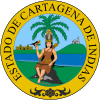Cartagena, Bolívar
| Cartagena | |||
|---|---|---|---|
| City | |||
| Cartagena de Indias | |||

Top: Bocagrande Harbour. Second row: View of Santa Cruz Manga Island, Heredia Theatre. Third row: ClockTower (Torre del Reloj), Pilar Republicano, San Felipe Barajas Castle (Castillo de San Felipe de Barajas) (above), Charleston Hotel (below). Bottom: City Skyline.
|
|||
|
|||
| Nickname(s): "The Magic City", "The Cosmopolitan City", "The city of Cartagena", "The Heroic" , "The Rock Corral" , " The fantastic" | |||
| Motto: "Primero la Gente" ("People First" (2016–2019) |
|||
 |
|||
| Coordinates: 10°24′N 75°30′W / 10.400°N 75.500°WCoordinates: 10°24′N 75°30′W / 10.400°N 75.500°W | |||
| Country |
|
||
| Department |
|
||
| Region | Caribbean | ||
| Foundation | June 1, 1533 | ||
| Founded by | Pedro de Heredia | ||
| Government | |||
| • Mayor | Manuel Vicente Duque | ||
| Area | |||
| • City | 572 km2 (221 sq mi) | ||
| Elevation | 2 m (7 ft) | ||
| Population (2016) | |||
| • City | 971,592 | ||
| • Rank | Ranked 5th | ||
| • Metro | 1,013,389 | ||
| Demonym(s) | Cartagenero(s) (in Spanish) | ||
| Time zone | EST (UTC-5) | ||
| Postal code | 130000 | ||
| Area code(s) | 57 + 5 | ||
| HDI (2008) |
|
||
| Patron saints | Saint Catherine and Saint Sebastian | ||
| Average temperature | 82º | ||
| Website |
www |
||
| UNESCO World Heritage Site | |
|---|---|
| Location |
Bolívar Department, Colombia |
| Coordinates | 10°25′25″N 75°31′31″W / 10.4236°N 75.5253°W |
| Area | 572 km2 (6.16×109 sq ft) |
| Criteria | iv, vi |
| Reference | 285 |
| Inscription | 1980 (8th Session) |
| Website | www |
|
[]
|
|
The city of Cartagena, known in the colonial era as Cartagena de Indias (Spanish: Cartagena de Indias [kaɾtaˈxena ðe ˈindjas]), is a major port founded in 1533, located on the northern coast of Colombia in the Caribbean Coast Region. It was strategically located between the Magdalena and Sinú rivers and became the main port for trade between Spain and its overseas empire, establishing its importance by the early 1540s. During the colonial era it was a key port for the export of Peruvian silver to Spain and for the import of African slaves. It was defensible against pirate attacks in the Caribbean. It is the capital of the Bolívar Department, and had a population 971,592 as of 2016. It is the fifth-largest city in Colombia and the second largest in the region, after Barranquilla. The urban area of Cartagena is also the fifth-largest urban area in the country. Economic activities include the maritime and petrochemicals industries, as well as tourism.
The city was founded on June 1, 1533, and named after Cartagena, Spain, which in turn was named after Carthage in Tunisia. Settlement in the region around Cartagena Bay by various indigenous people dates back to 4000 BC. During the Spanish colonial period Cartagena served a key role in administration and expansion of the Spanish empire. It was a center of political, ecclesiastical, and economic activity. In 1984, Cartagena's colonial walled city and fortress were designated a UNESCO World Heritage Site.
The Puerto Hormiga Culture, found in the Caribbean coast region, particularly in the area from the Sinú River Delta to the Cartagena Bay, appears to be the first documented human community in what is now Colombia. Archaeologists estimate that around 4000 BC, the formative culture was located near the boundary between the present-day departments of Bolívar and Sucre. In this area, archaeologists have found the most ancient ceramic objects of the Americas, dating from around 4000 BC. The primary reason for the proliferation of primitive societies in this area is thought to have been the relative mildness of climate and the abundance of wildlife, which allowed the hunting inhabitants a comfortable life.
...
Wikipedia




